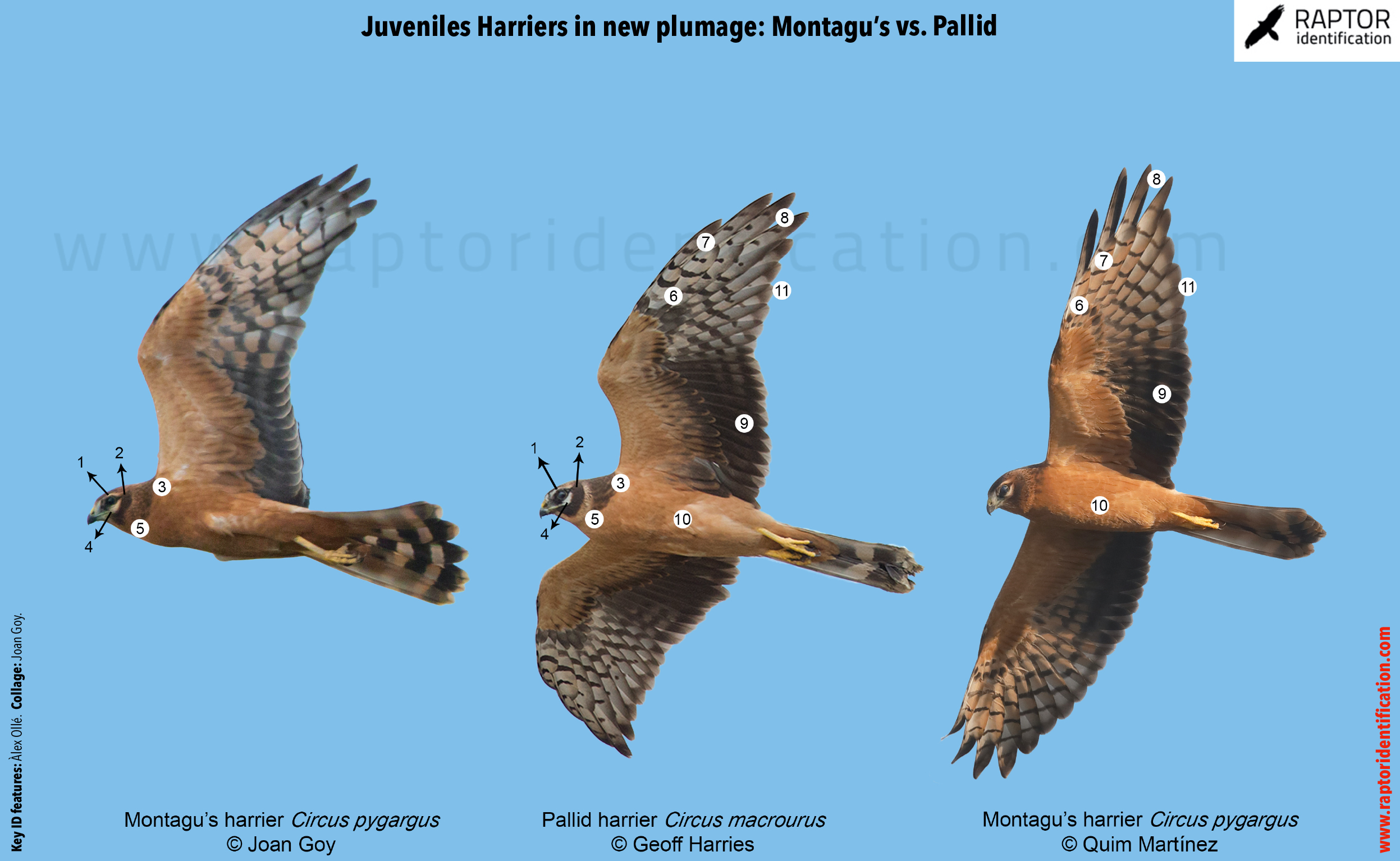Juveniles: Pallid Harrier vs Montagu’s harrier
1. PH: the majority tends to have a thin eyebrow, not really highlighted. However, it could be wider and resembling to MH.
MH: the eyebrow is fluctuatingly wide, usually more than in PH, resulting more prominent as a whole.
2. PH: the facial disc is evenly dark and spread, from the nape to the basis of the lower mandible. In worn-out plumage, they are less even, more listed.
MH: the dark facial disk from the ear tufts is less prominent and isolated, not usually connected to the nape nor the basis of the lower mandible. They rarely show a similar extension to PH, this causing a severe confusion afterwards.
3. PH: the dark “boa” around the neck is densely dark, but it usually loses such uniformity with erosion, and there’s even those which show it striated with a new plumage.
MH: the “boa” is mostly striated and blurred, barely prominent. However, there are individuals who again resemble to PH, especially females, which cause confusion.
4. PH: the white spot below the eye is always restricted to the length of the eye, forming a concave angle which ends right behind the eye, without connecting or spreading to the eyebrow.
MH: the white spot is mostly big, with a rounded shape scarcely defined, and above all, spreading behind the eye and joining behind it with the eyebrow.
5. PH: the clear collar is wide and neat, clearly outlining the dark cheeks. In case the facial disc is a bit coloured, it doesn’t emphasize so much.
MH: the classic specimens don’t show a prominent collar, but some do, especially if they have spread and uniform dark facial disk or the “boa”. It’s in these cases when recognition tends to be very complicated, and we have to attend other features such as wing design and structure.
6. PH: dark stripes at the base of more outer primaries tend to be faded, displayed as a whole as a clearer patch, which is called “boomerang”, which is always more or less exhibited.
MH: Montagu’s don’t usually show this sort of clear patch at the base of outer primaries, but there are birds which might also show it, at least in a subtle way.
7. PH: the dark stripes at the primaries tend to be wider than in MH, even though it’s a varying fact, and it could even be the exactly the same in some individuals.
MH: in classic birds the dark stripes are thin, almost arranged or organized, and in most cases are quite blurred or non-existing; but this is not only their case. Even though, there are some individuals, especially females, with wide dark stripes identical to PH.
8. PH: as a rule, the classic specimens only show some dark at the end of fingers, not spreading anywhere else, being the contrast quite evident, abrupt; although it could also vary according to the individual, and it’s not strange to find birds with this dark more spread.
MH: the immense majority tend to display fully dark tips of fingers, and this dark blurs throughout the feather; we’ll hardly ever observe a restricted and abrupt design such as classic PH’s.
9. PH: the back dark stripe from the primaries tends to be soft, not really prominent, but it’s again varying, and many individuals display it in a
highlighted way as in MH.
MH: They always display a back dark stripe on the wing.
10. PH: the secondary darks have a distinctive design in most birds, with one or two complete clearer stripes, even grey, being the outer one a bit wider. More rarely they show two clear stripes alike.
MH: classic birds draw two or three grey stripes at secondary darks, being these thicker alike. It’s very unusual to see a design with a single grey stripe.
11. PH: in new plumage, the general body colouring has an orange tone, brighter than MH, and with no streaks on the chest, flanks or under coverts.
MH: extremely varying in MH. From darker birds, to clearer and more alike to PH birds, although they tend to show thin, dark streaks on the chest, flanks, or small and median under coverts; even completely plain, as in PH.
